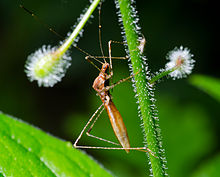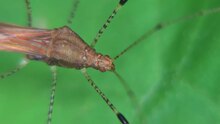Witchweed bug
| Witchweed bug | ||||||||||||
|---|---|---|---|---|---|---|---|---|---|---|---|---|

Witch's herb bug ( Metatropis rufescens ) |
||||||||||||
| Systematics | ||||||||||||
|
||||||||||||
| Scientific name | ||||||||||||
| Metatropis rufescens | ||||||||||||
| ( Herrich-Schäffer , 1835) |
The witch's herb bug ( Metatropis rufescens ) is a bug from the family of stilt bugs (Berytidae).
features
The bugs are 7.9 to 9.4 millimeters long and are among the largest representatives of their family in Central Europe. They are brown in color; the nymphs are initially yellowish, later green. Characteristic are the backward-pointing thorn on the scutellum as well as the black thickenings at the end of the thighs ( femora ) and the narrow black rings on the legs and antennae .
distribution and habitat
The species is distributed in Europe, with the exception of the far north and south, east to the Black Sea region and Siberia. It is common in Central Europe, but does not occur everywhere. It is common only locally. In the UK, it is common in much of the south, including Wales. Shady, mostly moist habitats in deciduous forests are populated, such as the forest edges, stream meadows and fresher areas with vegetation of food plants.
Way of life
The animals feed exclusively on witch herbs ( Circaea ), such as large witchweed ( Circaea lutetiana ), middle witch herb ( Circaea × intermedia ) and in the Alps also on alpine witchweed ( Circaea alpina ). The reproductive organs of the plants are mainly sucked. Hibernation takes place as an image under loose bark, in moss cushions or in dry litter . Mating takes place from May. The flight-active bugs can then not only be found on food plants, but also on other herbaceous plants and trees. The females lay their eggs individually on the stems and leaves of the food plants in June and July. From August, sometimes even in July, the adults of the new generation appear, although nymphs can also be encountered until September.
supporting documents
Individual evidence
- ↑ a b c d e Wachmann: Wanzen , Vol. 3, p. 190
- ↑ a b c Hexenkrautwanze (Metatropis rufescens (Herrich-Schaeffer, 1835)). Insects Saxony, accessed on June 21, 2014 .
- ↑ Metatropis rufescens. British Bugs, accessed June 21, 2014 .
literature
- Ekkehard Wachmann , Albert Melber, Jürgen Deckert: Bugs. Volume 3: Pentatomomorpha I: Aradoidea (bark bugs), Lygaeoidea (ground bugs, etc.), Pyrrhocoroidea (fire bugs) and Coreoidea (edge bugs, etc.). (= The animal world of Germany and the adjacent parts of the sea according to their characteristics and their way of life . 78th part). Goecke & Evers, Keltern 2007, ISBN 978-3-937783-29-1 .
Web links
- Metatropis rufescens in Fauna Europaea. Retrieved June 21, 2014

